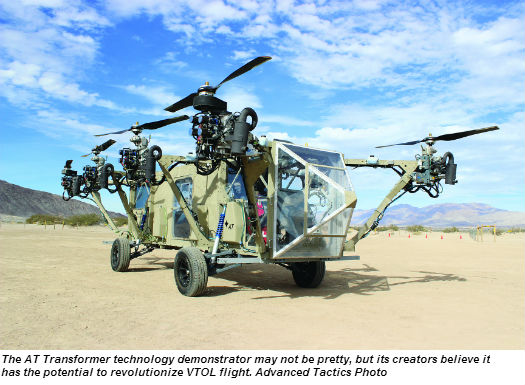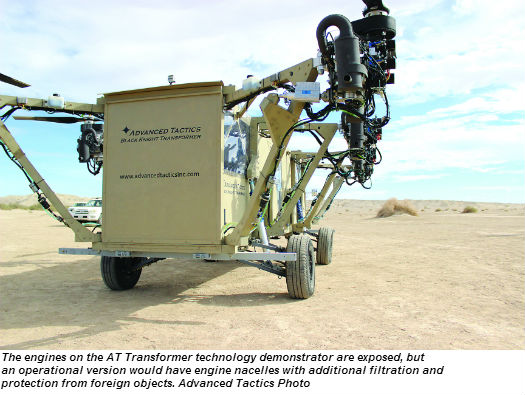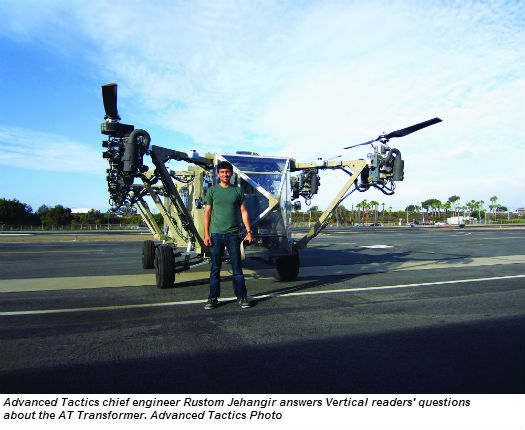
In January, Vertical shared a press release from Advanced Tactics concerning its AT Transformer technology demonstrator, a roadable vertical take-off and landing (VTOL) aircraft designed for autonomous casualty evacuation and manned or unmanned cargo resupply missions. The interest it received was dramatic — it was the most-viewed article on www.verticalmag.com for the month of January, edging out our first-person account of flying the AgustaWestland AW609 simulator — but the reception was mixed. Skeptics on the Vertical page on Facebook questioned its credentials, reliability, and practicality. As with the AW609, they also wanted to know whether the aircraft could autorotate in the event of a power failure.
Founded in 2007, Advanced Tactics is based in El Segundo, Calif., around 35 miles northwest of the Anaheim Convention Center. So, for Heli-Expo 2014, we asked Advanced Tactics chief engineer Rustom Jehangir to clear up some of our readers’ questions about the AT Transformer. First, some background on the program: it received initial funding in 2010 as a Congressional Special Interest program for development as a “multi-mission medical and casualty evacuation unmanned air vehicle/unmanned ground vehicle.” More recently, the company has been awarded research and development funding from the Marine Corps Warfighting Laboratory and the Air Force Research Laboratory, giving the program a bit more credibility than the typical garage-built “flying car.”
The full-scale AT Transformer technology demonstrator has a gross weight of 4,400 pounds (1,995 kilograms) and a payload of approximately 500 pounds. The operational concept — an eight-rotor, lightly armored vehicle called the “Black Knight Transformer” — will exist in roadable and cargo versions. The Black Knight’s payload will vary from 250 to 1,000 pounds, its range from 250 to 650 nautical miles, and its endurance from 2.5 to seven hours, depending upon the configuration (the company is also developing a six-rotor special ops version called the Panther Transformer, but is not releasing specifications for it). Advanced Tactics is targeting a service ceiling for the Black Knight of 20,000 feet, and the ability to hover out of ground effect at altitudes of up to 15,000 feet. At press time, the AT Transformer technology demonstrator had completed driving tests and was preparing for its first flight.
The following is an edited version of our Q-and-A with Jehangir.
Why Transformer technology?
The Transformer technology is first and foremost designed for casualty evacuation and cargo resupply missions; however, it is a multi-mission platform that can perform just about any mission suited to a conventional helicopter. It is also designed to be modular. For instance, the ground drive system can be removed, allowing more payload to be carried, or the interior of the vehicle can be reconfigured from casualty evacuation configuration to cargo resupply configuration.
Compared to a conventional VTOL vehicle, the Transformer can drive on or off road. This is a world’s-first capability for a VTOL aircraft and an engineering feat. It offers many new missions options. Imagine being able to “jump” over dangerous areas while driving, escaping from an ambushed convoy, or even driving back to base after the flight system has been damaged. Any of these situations would leave a driving-only or flying-only vehicle in a tight spot.
The Transformer has a much smaller physical footprint for its lifting capacity [than a conventional VTOL vehicle], meaning that it can operate in smaller spaces. It is even smaller when the engines are stowed for driving. It also has a much larger internal cargo volume than most helicopters: for instance, the Black Knight Transformer has comparable interior volume to a [Sikorsky] UH-60 Black Hawk, but at least four Transformers could park under the Black Hawk’s rotor.

Tell us more about the powerplants for the aircraft. How will you prevent foreign object and dust damage to the engines?
The technology demonstrator aircraft uses normally aspirated gas engines. The operational versions will use turbo-diesel engines that are more efficient and compatible with standard military fuels like JP-5 and JP-8. The engines that are used are designed for aircraft, are highly reliable, and have excellent performance at high altitudes. Most helicopters in the same weight class use turbo-shaft engines that are very expensive and less fuel-efficient. The turbo-shaft engines are much lighter for their power output, but the cost outweighs the benefit. Even though we use six to eight engines, the cost of all engines is less than a single comparable turbo-shaft engine. Our direct-drive design also eliminates the need for a transmission, saving weight, cost, and complexity. (The ground drive system is powered by a separate engine and automatic transmission.)
Because the powerplants are mounted externally to the vehicle, they are very easy to maintain and replace. They can even be replaced in the field if necessary. The current engines have air filters that do a good job of preventing dust damage. The operational version will also have engine nacelles with additional filtration and protection from foreign objects. The propellers are exposed, just like a helicopter rotor, but they are made of strong carbon fiber and resist damage from small debris.
What are the advantages and disadvantages of the six or eight-rotor configuration compared to traditional helicopter/VT OL designs?
The multicopter design is “dynamically stabilized,” meaning that it requires constant computer feedback to stabilize and control the vehicle. Conventional helicopters have highly coupled dynamics, meaning that one control input affects multiple axes of movement. Because multicopters are very symmetric (with counter rotating sets of prop-rotors) they don’t have this problem and they can be very precisely stabilized and controlled.
In terms of speed, multicopters experience some of the same issues as conventional helicopters such as retreating blade stall; however, the symmetry helps out again, countering the rolling-moment force that prevents conventional helicopters from reaching very high speeds. Additionally, the Black Knight Transformer may someday have rotating engines that provide extra forward thrust for higher speeds.
The Black Knight Transformer’s reliability benefits from the fact that it has significantly fewer moving parts than a conventional helicopter. The complexity of the helicopter rotor head is unnecessary due to the computerized feedback control system. The aircraft can’t autorotate like a conventional helicopter but it can maintain complete attitude control with a failed engine. This allows the vehicle to continue flying or to safely descend.
A full power failure must be avoided — the vehicle has a ballistic parachute recovery system like some aircraft to recover in a situation like this. The rotor of a conventional helicopter prevents the use of a ballistic parachute system, but the AT Transformers have an exposed fuselage that is ideal for such a system.

How do human pilots and drivers figure into the vehicles, if at all?
The vehicles are designed to be “pilot-optional.” This allows a pilot to fly and drive the vehicle directly for complex missions and in areas where unmanned vehicles are not allowed, such as FAA [Federal Aviation Administration] airspace. The autonomous flight system is used for “dull, dangerous, or dirty” missions like cargo resupply and casualty evacuation.
Are you aware of any similar “Transformer” projects being developed elsewhere, and how do your Transformer vehicles compare?
We are only aware of the DARPA Transformer TX [a Defense Advanced Research Projects Agency program that awarded R&D funding to Lockheed Martin’s Skunk Works]. The operational concept design of the Black Knight Transformer can meet or exceed all of the goals of the DARPA Transformer TX program. Our design is more practical, robust, and economical because we do not rely on dual turbine engines, cross-shafting, complex ducted fans, or an “F-35 Lightning”-like control system (info from “DARPA TX” Wikipedia page).
Do you have a sense yet of how much Black Knight and Panther might cost per unit?
We can’t release an exact number, but it will be much less expensive than a conventional helicopter. Keep in mind that we were able to develop the technology demonstrators from the ground up with less than $2 million of U.S. government funding, which is less than the sale price of a typical turbine helicopter. The vehicle is designed specifically to meet the needs of the future military where low-cost systems are very important. Many of the missions we could perform, such as casualty evacuation or cargo resupply, are not cost-effective with aircraft that cost tens of millions of dollars to own and operate. Our vision for the AT Transformer is for it to become a mainstream vertical lift technology that provides affordable and enhanced capabilities to both military and civil users.









